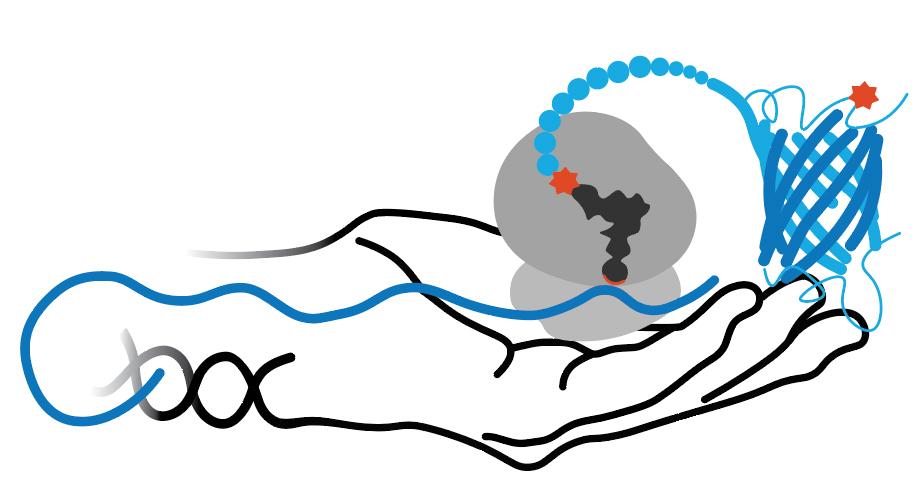GCE Publications
Displaying 1351 - 1375 of 1406 results
| Links to Article | Year | Article Title | Author(s) |
|---|---|---|---|
| 1980 | Role of minimization of chemical distances between amino acids in the evolution of the genetic code. | J Wong | |
| 1980 | In vitro synthesis of L-pipecolate from L-lysine: inconsistent with epsilon-N-acetyl-L-lysine as an obligatory intermediate | M. Hernandez, Y. Chang | |
| 1976 | Iatrogenic lesions of the skeleton. Caldwell lecture, 1975. | R Murray | |
| 1964 | ENZYMIC SYNTHESIS OF EPSILON-N-ACETYL-L-LYSINE | W. Paik, S. Kim | |
| 0 | "Genetically encoding an aliphatic diazirine for protein photocrosslinking" | ||
| Bromodomain protein Brd3 associates with acetylated GATA1 to promote its chromatin occupancy at erythroid target genes | J. Lamonica, W. Deng, S. Kadauke, A. Campbell, R. Gamsjaeger, H. Wang, Y. Cheng, A. Billin, R. Hardison, J. Mackay | ||
| Mechanism-Based Inhibition of Sir2 Deacetylases by Thioacetyl-Lysine Peptide | B. Smith, J. Denu | ||
| Polyspecific pyrrolysyl-tRNA synthetases from directed evolution | L.-T. Guo, Y.-S. Wang, A. Nakamura, D. Eiler, J. Kavran, M. Wong, L. Kiessling, T. Steitz, P. O’Donoghue, D. Söll | ||
| Disrupting the interaction of BRD4 with diacetylated Twist suppresses tumorigenesis in basal-like breast cancer | J. Shi, Y. Wang, L. Zeng, Y. Wu, J. Deng, Q. Zhang, Y. Lin, J. Li, T. Kang, M. Tao | ||
| A short guide to histone deacetylases including recent progress on class II enzymes | S . Y. Park, J. Kim | ||
| N-Acetyl lysyl-tRNA synthetases evolved by a CcdB-based selection possess N-acetyl lysine specificity in vitro and in vivo | T. Umehara, J. Kim, S. Lee, L.-T. Guo, D. Söll, H.-S. Park | ||
| Targeting the BRD4/FOXO3a/CDK6 axis sensitizes AKT inhibition in luminal breast cancer | J. Liu, Z. Duan, W. Guo, L. Zeng, Y. Wu, Y. Chen, F. Tai, Y. Wang, Y. Lin, Q. Zhang | ||
| Unraveling the hidden catalytic activity of vertebrate class IIa histone deacetylases | A. Lahm, C. Paolini, M. Pallaoro, M. Nardi, P. Jones, P. Neddermann, S. Sambucini, M. Bottomley, Lo Surdo, A. Carfi | ||
| Negative regulation of forkhead transcription factor AFX (Foxo4) by CBP-induced acetylation | M. Fukuoka, H. Daitoku, M. Hatta, H. Matsuzaki, S. Umemura, A. Fukamizu | ||
| PBRM1 acts as a p53 lysine-acetylation reader to suppress renal tumor growth | W. Cai, L. Su, L. Liao, Z. Liu, L. Langbein, E. Dulaimi, J. Testa, R. Uzzo, Z. Zhong, W. Jiang | ||
| Novel Histone Deacetylase Class IIa Selective Substrate Radiotracers for PET Imaging of Epigenetic Regulation in the Brain | R. Bonomi, U. Mukhopadhyay, A. Shavrin, H. Yeh, A. Majhi, S. Dewage, A. Najjar, X. Lu, G. Cisneros, W. Tong | ||
| Redox regulation of FoxO transcription factors | L.-O. Klotz, C. Sánchez-Ramos, I. Prieto-Arroyo, P. Urbánek, H. Steinbrenner, M. Monsalve | ||
| The 26S Proteasome Utilizes a Kinetic Gateway to Prioritize Substrate Degradation - PubMed | |||
| Expanding and reprogramming the genetic code | J. Chin | ||
| Site-Specific Introduction of an Acetyl-Lysine Mimic into Peptides and Proteins by Cysteine Alkylation | R. Huang, M. Holbert, M. Tarrant, S. Curtet, D. Colquhoun, B. Dancy, B. Dancy, Y. Hwang, Y. Tang, K. Meeth | ||
| Genetic code expansion in stable cell lines enables encoded chromatin modification | S. Elsässer, R. Ernst, O. Walker, J. Chin | ||
| Efficient genetic encoding of phosphoserine and its nonhydrolyzable analog | D. Rogerson, A. Sachdeva, K. Wang, T. Haq, A. Kazlauskaite, S. Hancock, N. Huguenin-Dezot, M. Muqit, A. Fry, R. Bayliss | ||
| N ε–Methanesulfonyl-lysine as a non-hydrolyzable functional surrogate for Nε-acetyl-lysine | N. Jamonnak, D. Fatkins, L. Wei, W. Zheng | ||
| Multivalent engagement of chromatin modifications by linked binding modules | A. Ruthenburg, H. Li, D. Patel, C. Allis | ||
| Efficient genetic encoding of phosphoserine and its nonhydrolyzable analog | D. Rogerson, A. Sachdeva, K. Wang, T. Haq, A. Kazlauskaite, S. Hancock, N. Huguenin-Dezot, M. Muqit, A. Fry, R. Bayliss |
